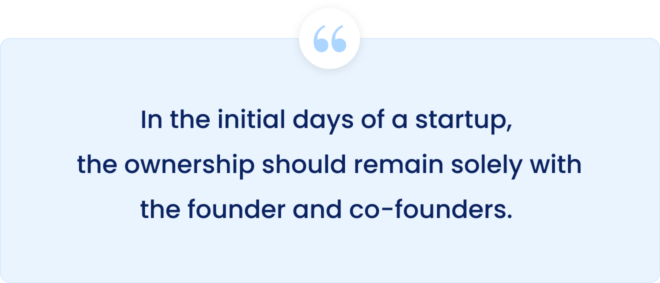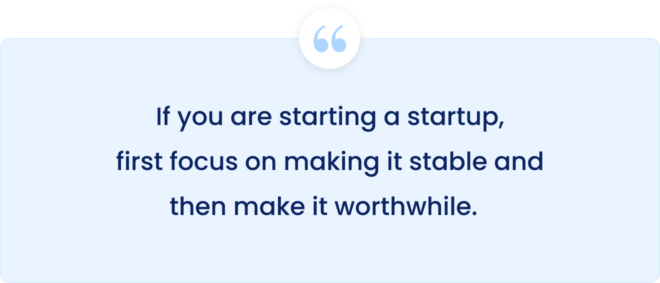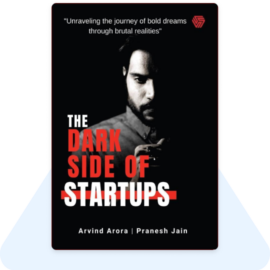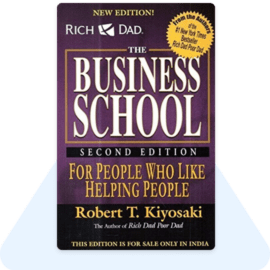The fancy world of Startups excites us all and we all so intrigued to know all about this sector. Your wait is over and now all the things regarding this buzzing sector will be revealed to you so that you can also plan your moves accordingly.
Introduction
Today, you will learn about the book “The Dark Side of Startups” by Arvind Arora, also known as A2 Sir and Pranesh Jain.
Through real-life stories and expert insight, this book sheds light on the struggles, setbacks, and ethical or unethical things behind the glamour of startup culture. It is an eye-opener for ambitious founders, investors, and college students, revealing essential lessons learned from the shadows of the startup world. If you are also one of those who have ever thought about a startup or have started one, this summary will be handy for you.
Arvind Arora is a famous Indian teacher, motivational speaker, and social media influencer. He has 20 million followers on different platforms; he is generally known as A2 Sir. He was featured in Shark Tank India Season 2 and has gained immense popularity through his YouTube channel “A2 Motivation”, with over 15 million subscribers.
Pranesh Jain is a member of the Institute of Chartered Accountants of India. He is a well-known financial data analyst, startup forensics and due diligence advisor in India. He has worked with over 500 funded startups and has much experience in the startup ecosystem.
He is an Angel Investor and Venture Partner in VC firms. He has also given over 200 sessions on startup ecosystem and financial education. So, by now, you must have understood how powerful and valuable this summary will be.
This summary may be long because the content of this book is beneficial. So do read the summary till the end. And if you like the summary, do read this book in detail. This book is available in Hindi and English on Amazon and Flipkart.
For your convenience, the links are at the end of this summary. To make the book easy to understand, we have explained its essential lessons in 9 chapters.
So, let’s start.
Chapter 1: Caution in the company’s share allotment in the initial days of startup
Many people are interested in joining and owning a company when it starts. A startup founder needs to think in the initial days about how much the value of his business will increase or what can happen. They only want good people to join them, so their decision seems straightforward.
The only thing that needs to be corrected here is the ownership of the shares they want to give. Are they providing any written commitments for this? And if not, what would be the situation when that person intends to exit the company? How will they deal with it?

A founder needs to understand that in the initial days of a startup, the ownership should remain solely with the founder and co-founders. If you are thinking of making someone a co-founder who is your close friend or colleague, then it is also necessary to agree with them in writing. Sometime back, the author faced a strange situation in a funded startup.
A founder gave 2% equity shares to a colleague based on informal commitments. This colleague had to work together and contribute to the company’s development. However, within just two months, he had to go abroad for further studies. Based on verbal commitments, 2% of equity shares went to someone who had not contributed anything to the company.
When the company’s valuation reached 7.5 crores, the value of that person’s shares became 15 lakhs. It is surprising how a single mistake can lead to such results. Although the founders and the company have legal options, the question is whether they have the time and money required for such a tedious process. So take care of it.
Chapter 2: Raising funds without proper understanding and conducting funding rounds at the wrong valuations
When a startup decides to raise funds, they need to properly understand their startup’s financial situation, market potential, development and the value it can provide to investors. New startup founders need to be aware of these issues.
We often wonder how startup founders decide on their terms about the valuation of their company. You must be wondering how this is possible, but this is India, my friend; here, everything is possible. To understand how this happens, let’s explore the methods of startup valuation calculations.
The valuation of any startup company is decided based on its future cash flow through registered valuers or merchant bankers. Here, a startup founder raises funds by imagining the company’s future, making it easier for small startups to raise funds.
However, they may need to realise that today’s solution may become a problem tomorrow and be made aware of the challenges they may face in the future. You will see that young entrepreneurs are raising funding at a 10 to 20 crore valuation even in the pre-revenue stage, the initial business startup phase. What’s wrong if investors are pouring money into startups at those valuations?
Money is invested by people who need the right investor mindset in small startups. Usually, due to advice from some mentors or personal contacts, these people invest in startups, which is okay. Here, our point is towards the startup founders: After raising funds on the wrong valuation, where can problems arise for you in the future?
Now, we need to understand this situation through an example. Let’s think of a startup founder who forms a company and, after just 20 days, takes funding of 20 lakhs at a valuation of 10 crores. This funding is to help them develop their product. After about two months, the product is ready, and the total development cost is 15 lakhs.
He started selling the product. They spend a lot of money on marketing and building a new team. If the sales are good and everything is going well, they can get the estimated valuation quickly. But if the sales are not good, it will be difficult for the founder to raise funding at such a high valuation. In this case, he must either reduce the valuation or invest his savings in the business.
The latter option can be risky, as it can drain all personal savings and may still need to yield the desired results.
Ultimately, even if they consider taking an unsecured loan from a bank, this situation must be addressed. This situation teaches us to avoid getting trapped in appearances, and raising funds from investors at the correct valuation for our startup is necessary.
There may also be a need to give up a little more equity if needed, but starting with the wrong valuation can cost you money in the future. Founders often realise this when they raise funds at high valuations and then spend the funds, but understand the reality much later. Founders must know that the short-term satisfaction of raising funds at high valuations can lead to long-term challenges.
Chapter 3: Leaving a Profitable Business and Starting a Startup
Many youths in our country come from wealthy families, and their families are engaged in many profitable businesses. However, nowadays, every other youth in the government wants to start a startup. They are also taught and motivated about startup-related things when they go to college. In such a situation, no youth would like to continue the family business in the old ways because they do not get as much freedom as they can get through their startup.

So, they leave the profitable family business and work passionately to start their startup. Although there is nothing wrong with this, the author points out he has seen many successful startups where young people have created a new identity for their profitable family business in the startup world. If you are starting a startup, first focus on making it stable and then make it worthwhile. Remember the stability and profitability factors in the race to grow a startup.
A startup doesn’t become successful just by becoming a unicorn; It becomes successful in real when it becomes stable and profitable in itself. From where your startup can become more significant, understand from that day that all your decisions will be correct, whether they involve investment funding or bank loans.
Chapter 4: Choosing to start a startup over a job
Whenever we hear the word “job”, we imagine a vast segment of society that supports their entire family from these jobs alone. Even today, many youths are working in some companies but are constantly looking for opportunities to start a startup.
Some get a chance and leave their jobs for a startup. Some start their startup while working until they are confident it is doing well. There are many such startups in the country whose founders first took up a job and then started their startup.
However, most startups that have shut down have had their founders return to their jobs. Some founders have created new startup resumes and are still trying to better themselves and their startups in the startup world. Both options are all right.
If you are currently working and want to start a startup to do something new, then all avenues are open for you in the startup world. Conversely, if you get frustrated with startup life and are worried about the success of your startup, you can always go back to your job.
Now, the issue is understanding whether to stay in the job, switch to startup, or return to the work from startup. You must see whether your present position permits you to survive. Take this decision by yourself and work accordingly. If you know that your survival is at risk, and yet you continue to hope for the success of your startup, then you are putting yourself and your family at risk. Therefore, before starting a new startup, your income or savings should be more or at least equal to survival.
Chapter 5: Turning investors into founders
It is like a maze that many startup founders often get stuck in. You must have also seen episodes like this in a famous channel on National Television, where startup founders have given investors a significant stake in their company, making the investor the founder and giving them the right to make all the decisions inside the company. Let’s understand it closely.
The startup is considered an achievement for any founder. Simply put, a startup is the story of a founder’s struggle, which makes him an owner, not an employee. In any startup, the rights of investors are minimal. Although investors get ownership rights in startups, they do not have any direct participation in the company’s business operations.
In a startup, the founders can run the business and make decisions without restrictions. If you turn your investor into a founder, it may limit your freedom to make decisions somewhere. The primary purpose for which you started the startup needs to be discovered, and you become an employee in your own company.
Two founders from IIT Bombay started an innovative healthcare device company a few years back. They worked hard to create a fantastic product combining technology and health items. They raised funds from a handful of angel investors to develop this tool. After the product was ready, the company needed money for the production and distribution of the product.
To meet this need, they closed their next funding round with an investor who was given equity in the company and became a co-founder. The investor was in a good financial position and spent six months understanding the product and its market potential. Later, the investor brought people from his team to the company, who helped the founder produce the product and, in this way, understood the secret things by staying with the founder.
Within a year, the investor made a firm hold on production, distribution and market. After this, the investors started creating conflicts inside the company and pressured the founders. Gradually, the investors took over complete control of the company and pressured the founders to such an extent that they had no option but to resign for survival.
Chapter 6: Startups getting funding from the wrong investors

An investor in a startup is like an angel who nurtures the startup and takes it to greater heights. However, finding an angel investor is also a big challenge. When you are in a startup, it is essential to understand that investing is risky.
The entire amount invested may go to waste. Or they could make 100x profit. Every startup founder is aware of the fact that only some startups will be a hit. You must understand their mentality to convince investors to invest in your company.
Have they invested before? Because if they are aware of the risk of investment, then you do not have to worry, but if they do not have a good understanding of investing, it may cause you some trouble.
If your startup cannot generate profitable returns according to their expectations, then problems may arise. Many startups and founders have gone through a similar situation where they took investment from investors who need an investment mindset.
This was the reason that later he had to face trouble. Often, these investors pressure the founders to work to get their money back. Many investors misbehave with the founder, and there are problems with their work abilities, and finally, the startup needs better results.
Chapter 7: Continuing to Invest in a Startup Despite Running Losses
About 80% of the unicorn startups in the country still need to be profitable. The startup ecosystem has evolved in such a way that profitability is not a requirement for the valuation of a startup, which acts as a benchmark for the founders.
The valuation of a company depends on different factors. Even those startups running in loss from the beginning hope to turn their startup into a unicorn one day. By continuing this expectation, startups will have to bear losses while increasing their valuation and other factors.
You can turn your company into a unicorn by playing funding rounds if the funding keeps flowing. However, if the funding runs out before or after you achieve unicorn status, you have three options.
The first option is to do a buyout for your company. The second option is to take out an IPO (initial public offering) for your company. The third option is to close the company. The funny thing is that from starting a startup to becoming a unicorn, and even after becoming a unicorn, there are plenty of risks for you.
However, amidst all this, you, as a founder, get a good salary from the company, which keeps your survival worries away. Real money is made when your avenues open for the first or second option. Now, you must have understood why startup founders take the risk of running a startup at a loss so that when the company grows, they get a good profit from the shares.
Chapter 8: Focus on leading products/services

Most startups get distracted after getting funding and need help understanding the purpose behind creating a startup. Forgetting all this, they try to sell their company and product/service as just a brand. This distracts their focus.
When a startup has multiple products/services, it should focus on the leading product/service and improve its quality so that no other product/service or brand can compete. This gives your startup a Unique Selling Proposition (USP) in the market. Creating one high-quality product/service is better than coming to the market with many high-quality products/services.
Chapter 9: Things needed to start a startup
For this, first of all, you have to go through these processes:
Idea: First of all, you must have a business idea. Before preparing for your startup and working on it, validate your vision thoroughly and whether it has a demand in the market. This way, when you start working on an idea, you will be ready to enter the market with a more robust business model.
Planning & Execution: At this level, you will have to assign the responsibility of taking necessary actions, and along with this, you will have to take care of the market demand. If your product development is not done correctly, you will soon be out of the startup race. You will get to know about it from product testing and market response.
Revenue Generation: Make the sales strategy of the company at this stage. Note that create as many multiple income sources as possible.
Funding Round: Funding is taken at different levels in different startup phases. For example, in the early days of a company, angel investors provide funds. The company gets super angel or some family office funding in the revenue phase.
As soon as the company successfully starts its business journey and grows with good revenue, Venture Capitalist (VC) companies show interest in funding according to the product market and keeping in mind the business model. The journey towards becoming a unicorn begins right here.
Exit Strategy: A startup founder is not successful when he gets funding; Rather, a startup founder becomes successful when he exits the startup at the right time and makes money from it. Planning your exit strategy is essential for a startup founder. An adequately made exit strategy benefits the founder and gives investors good returns. Generally, in a startup, the founder of the investors have the following options for exit:
- Acquisition: Selling a startup to a large company that sees good profits in the startup’s technology, product, or customer base.
- IPO (initial public offering): Making a startup public by listing its shares on a stock exchange. This allows investors to sell their shares in the general market.
- Merger: Merge a startup with another company to create synergy or scale more effectively.
- Management buyout (MBO): Selling a startup to its management team, allowing the founder and a few employees to take control.
- Liquidation: Closing the business and selling its assets.
- Private Equity Buyout: Selling the startup to a private equity firm that wants to increase its valuation and then sell it at a higher price.
Chapter 10: How to register a company in India

To register a company in India, you must follow several stages and complete different formalities. Here’s a simple overview of the process:
- Decide what kind of company you want to register. Standard options include Private Limited Company, Public Limited Company, Limited Liability Partnership (LLP), etc.
- Take a Digital Signature Certificate (DSC)
- Get Director Identification Number (DIN)
- Name reservation: Choose a unique name for your company and apply for spice part a service through name reservation on the MCA portal.
- Prepare a contract of documents: Prepare necessary documents, including a Memorandum of Association (MOA) and Articles of Association (AOA). These documents give an overview of the company’s purpose, rules and regulations.
- Fill Incorporation Documents: Once the name is approved, complete the incorporation documents, including MOA, AOA and other necessary forms from the SPICe (Simplified Proforma for Incorporating Company Electronically) setup on the MCA portal. Pay the fees. Pay the required stamp and additional incorporation fees based on the company’s authorised capital and other factors.
- Certificate of incorporation: Once the MCA processes your application and documents, you will get the certificate of incorporation. This is the proof of official registration of your company.
- Apply PAN and TAN
- Open a bank account
- Compliance and Registration: After registration, ensure compliance with various legal and regulatory requirements, such as Goods and Services Tax (GST) registration, if applicable, and any other necessary licenses or permits.
Chapter 11: The documents required for the incorporation of the company are
- Director Identification Number (DIN)
- Digital Signature Certificate (DSC)
- Memorandum of Association (MOA)
- Articles of Association (AOA)
- Proof of Registered Office
- Proof of Identity and Address
- Passport-size photographs
- Declaration of consent
- Form DIR-2 and DIR-8
- No Objection Certificate (NOC)
- Utility bill
- PAN Card
- Declaration of Commencement of Business (Form INC-20A)
Now you can decide what type of company you want to register: Sole Proprietorship, Partnership Firm or Limited Liability Partnership. They have advantages and disadvantages, which you will get in this book.
Chapter 12: Startup Business Model
There are many different types of startup models. The author has given more than 20 business models in the book. We will discuss here only some vital business models.
Freemium business model: (freemium = free + premium) In the freemium model, users can use the essential services of a software, game or service for free, motivating them to learn and engage with themselves. After some time, users can “upgrade” and pay fees to get additional or advanced features. For example – Gmail, Google Drive, iCloud, etc.
Subscription Business Model: The subscription business model involves providing products or services to customers regularly in exchange for regular subscription fees. This model has gained immense popularity across different industries due to its potential to generate predictable and stable revenue streams. Examples: Amazon Prime, Netflix and Shopify.
Marketplace Business Model: In the marketplace business model, a platform is created where buyers and sellers can interact and transact. In this model, the marketplace operator facilitates these interactions and generates revenue in different ways, such as commission, listing fees or membership fees. For example – Flipkart, Snap Deals, and Amazon.
Aggregator Business Model: In the aggregator business model, a platform is created that collects information, products or services from different sources, combines them and displays them in front of users quickly. Aggregator platforms add value to a customer’s life by establishing well-established service provider access and helping users make informed decisions—for example, Ola Taxi, Uber, AirBnB, and Rapido.
Pay-as-you-go business model: The pay-as-you-go business model, also known as a use-based or consumption-based model, involves customers paying for products. This model provides flexibility to users, allowing them to pay only for their usage rather than committing to fixed plans or contracts. Example: Amazon Web Service (AWS).
Conclusion
So, friends, this is the summary of the book Dark Side of Startup, in which the author discusses all the challenges and opportunities related to startup. There are 39 chapters in this book, and we have covered 12 chapters of its summary. You must read this book in detail for the rest of the chapters.
If you also want to know how to use a Startup fund, what is the reality of Startup unicorns and Big Startups, how to avoid toxic culture in startups, how startups have ruined your personal life, and what to do if investors back out of their investment commitments.
You will get all the information in this book from beginning to end. This is a complete book for those interested in startups. So, please read this book now and understand it in detail from the link in the description. In this book, you will get answers to all your questions.
The Dark Side of Startups Book Review
Arvind Arora and Pranesh Jain give you insights and inner wisdom of this glamourous Startup sector. From the details of how to register a company to funding it further so that it can become a Unicorn, both these authors have left nothing unturned to make sure that the readers of this book get to know everything in and out.
The book unveils most of the hidden secrets of the Startup world for its readers and is very effective in understanding the minute details.
However, the book has a specific sector which may not be a concern for many readers. But, for the one who wants to venture or understand this Startup culture, this book will prove a goldmine.
Thank You.
Contents













